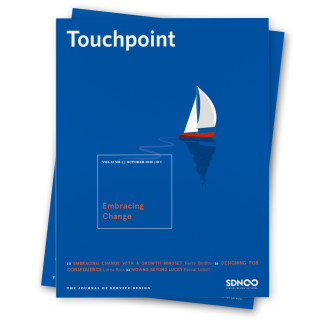Organisations seem to have two ways of dealing with change. Some accept its inevitability and find ways to embrace it. Others resist it, hoping to preserve the world they know instead of the one that’s rushing towards them. Most fall into the latter category.
There are neurological reasons for this. The human brain is not built to imagine what is not here yet, it is built to recognise what is here already. In the words of Marshall McLuhan, “When faced with a new situation, we tend to attach ourselves to the objects and the flavour of the most recent past. We look at the present through a rear-view mirror. We march backwards into the future.”
Even in the heat of invention, we are not always able to untether our minds from the past. Consider the automobile. The early prototypes were not called horseless carriages for nothing; they looked an awful lot more like carriages than what we have come to know as ‘cars’. It took about 30 years for them to come into their own form, one which would look absolutely ridiculous with a horse in front of it. But one hundred years later, we still measure an engine’s power in ‘horses’ and we still call them ‘cars’ – which is itself just short for ‘carriage’.
We are now living through a technological disruption the scale of which is not unlike the period of innovation that gave birth to the automobile, electricity and telephony back in the late 19th century. It is by now a cliché to say that the post-industrial process of digitisation is changing everything, from products and services to how we live and work. And that change has been accelerated by a once-in-a-century global pandemic that has turned everyone’s life upside down.
This view is shared by Monty Hamilton, Chief Digital Officer of TELUS, one of Canada’s largest telecom companies. A native of Melbourne, Australia, Hamilton had just begun his remit with Vancouver-based TELUS when the world went into lockdown. As he tells it, “With a young family, I was commuting between Vancouver and Melbourne. I got back to Australia on the 21st of March on one of the last flights out, and then Australian borders pretty much shut down on the 22nd. All of the lockdowns followed and here we are seven months later, still working the night shift, but, like millions of others, finding ways to navigate in these unprecedented conditions.”
Because digital transformation is his mandate, you could say that embracing change is at the core of Hamilton’s role. As he puts it, “Digitising our business is not a strategy at TELUS. It is THE strategy.” And to execute on that strategy, Hamilton believes that everything TELUS does must be underpinned by data and design. He explains: “When we talk about experiences enabled by data and design, our goal is that every interaction an employee or customer has with TELUS is enriched by the one before it and should enrich the one after it.” He sees the relationship between design and data as a combination of art and science, wherein the science of data informs the art of design and design humanises the data: “We’re operating at the intersection of IQ and EQ.”
The role of service design in this effort is critical. Judy Mellett, Director of Service Design at TELUS, explains: “Data informs us about where to look for opportunities and design humanises our solutions. Design helps us redefine the future through rich insights, innovative methods and collaborative processes that are different from the ones that got us here in the first place. We need to reimagine the future experience instead of making incremental changes to the current one.”
Here she gives an example of how service design informs the process of digital transformation. “Historically, when you think about getting TV or internet, you have to call in, make an appointment and take the day off to be there when the technician arrives. From a customer experience perspective, it’s a messy, disruptive process. All the customer wants is to be able to watch their shows or stream their content. So we are re-examining what it is we are truly selling and looking at ways of disaggregating these processes through data and design.”
Invoking the metaphor of the rear-view mirror, Hamilton agrees: “We are saying let’s not add to all the complexity of a legacy system that was built up over time but instead let’s reimagine it from the customer experience perspective. Why try to recreate an established or analog product or service in a digital environment that the product was never designed for? Incumbents really struggle because they too often try to bash an offline product into an online one. But the future is not just a digital version of the past. That’s why service design and data and journeys are so important. It allows you to challenge the historical beliefs about how that product should be distributed or manufactured versus how it was in the past.”
Another key insight is that in the past, digital was very channel-specific and siloed, with activity up and down the verticals but very little sharing of data across them. But as Mellett points out, “We have to remember that humans aren’t channel-specific; we are not their only source of information about our products and services. They are also going to social media or talking to friends and family, so that’s another reason why you need a way of thinking from the consumer lens about where are they interacting, what are they doing and the resulting behaviours.”
Adds Hamilton, ”As a multichannel business working together across the organisation to design for digital, we’ll make those products easier and better for our team members and customers, whether they are sold in the store or over the phone. We look at it as almost a kaleidoscopic customer journey and that’s where service design and digital experience design intersect.”
As with everything else, the pandemic has reshaped that challenge. Hamilton continues: “There’s no foreseeable return to normal. Our reality has been changed forever along two axes: feasibility and desirability. Here’s my personal example: let’s say they develop a vaccine for the virus. Even though the vaccine makes it scientifically feasible, sitting on an aircraft surrounded by other people in close proximity is still not desirable for me. As a proud multichannel organisation we have to be very tuned into this reality. For example, having retail stores across the country is important, but the desire of some of our customers to use them, how we use them and operate them needs to change. The pandemic means that we have to design products where we can have less human-to-human interaction. To solve for that requires going beyond the digitisation of traditional products to the complete rewiring of them from a data and design perspective. They need to be ‘born digital’.”
Covid-19 is quickly revealing the companies who are already on that path and the ones who aren’t. Says Mellett: “We long ago said the things we are selling are to some extent commoditised, so now experience is going to be the mechanism to help differentiate us. What Covid-19 has done is highlight the urgency, but it doesn’t change the plan. Who knows? This could be a dress rehearsal for something bigger. So now it’s about who is already there and who is scrambling to catch up.”
In the end, breaking through the rear-view mirror means designing products and services that are ‘born digital’. Monty Hamilton asks, “Are we running the digital branch of the company or are we digitising all aspects of the company? As we have said, digitising our business is not a strategy, it is THE strategy. It reduces customer effort, which reduces our cost to serve and increases retention, likelihood to recommend and repeat purchase. Successful digitisation is our definition of success as a business, but it’s not about shameless cost reduction or indoctrinating customers. It’s about enabling choice and doing so by pulling all three points of the triangle: being better at business, better at technology, and enabling a better customer experience, all underpinned by design and data.”





Share your thoughts
0 RepliesPlease login to comment